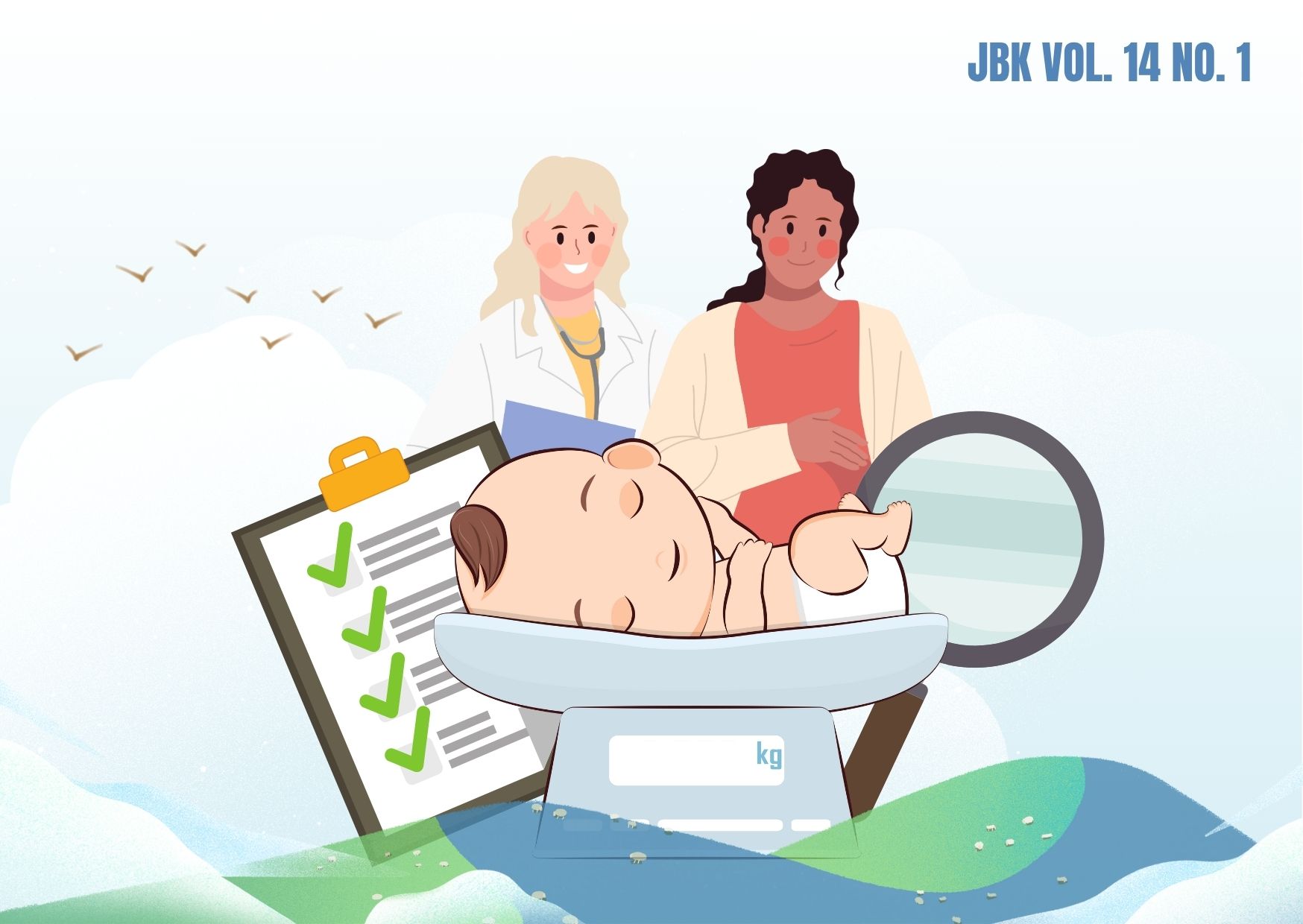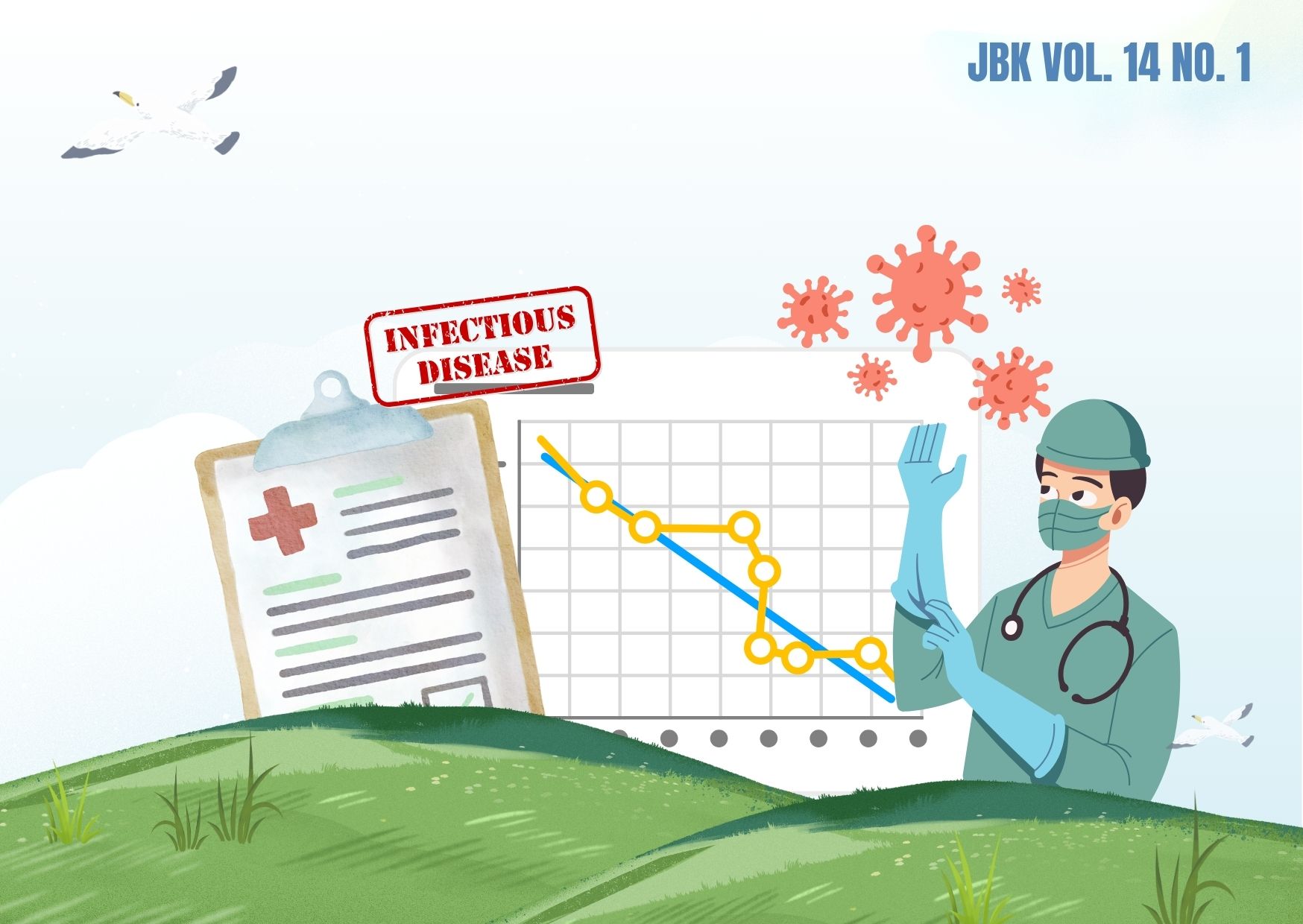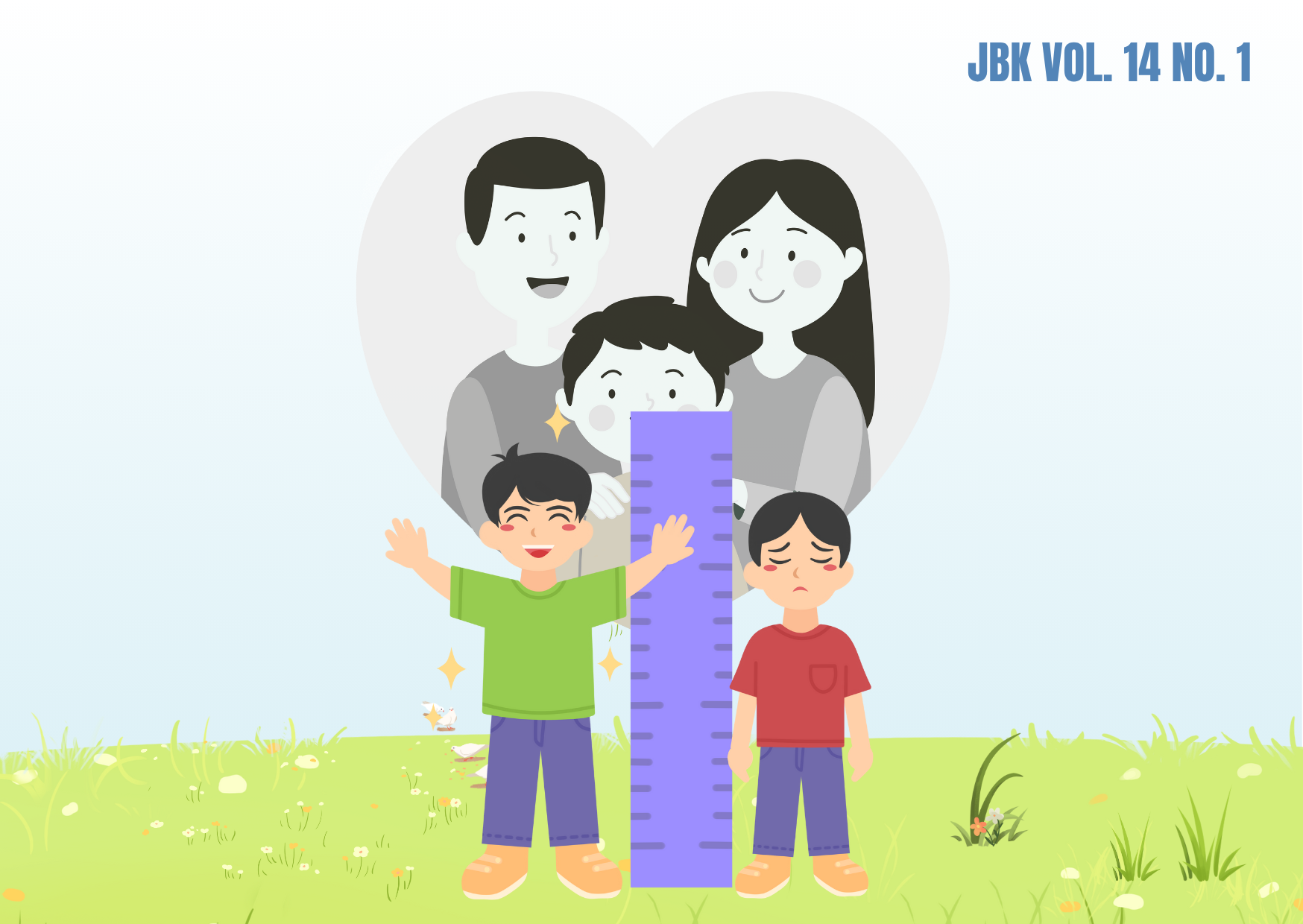CONTRACEPTIVE CHOICE AMONG COUPLES OF CHILDBEARING AGE (PUS) IN BENGKULU PROVINCE
Downloads
Contraceptives are very useful in achieving the family planning (keluarga berencana) program; however, not all contraceptives are suitable for everyone. The choice of contraception depends on how each person must be able to choose a contraceptive that is suitable for him or her. In general, there are two methods of contraception, namely modern and traditional. The government recommends couples of childbearing age or pasangan usia subur (PUS) to use the modern method, as it is more effective in preventing pregnancy. This study was conducted to determine factors (predisposing, enabling, and reinforcing) that influenced the use of contraceptives in Bengkulu Province. The research design was cross-sectional and used secondary data from the Performance Survey and Accountability Program/Survei Kinerja dan Akuntabilitas Program (SKAP) in 2019. The sample of this study was couples of childbearing age ranged 15-49 years old in Bengkulu. The results showed that 232 couples (59.9%) used modern contraception, while 155 people did not use modern contraception (40.1%). The results of the bivariate analysis of predisposing factors show that there is a relationship between work, education, and attitudes towards using family planning in the future, while age and knowledge are not related. It was also found that there are relationships between enabling factors such as place of residence, level of welfare, number of children, desire to have children, and informed choice. Meanwhile, there is no relationship between insurance membership and mass and room information media. It is known that there is no relationship between reinforcing factors in information sources for health workers, non-health workers, information sources for formal institutions, and information sources for non-formal institutions with the selection of contraceptive methods. The factor that most influenced the choice of family planning methods among the respondents aged 15-49 years in Bengkulu was informed choice with OR of 20.11 (95% CI = (11.24-35.98).
Ahmad, S., Hutagaol, E. dan Malara, R., 2014. Hubungan Pengetahuan Ibu Usia Remaja dan Dewasa Muda tentang KB Dengan Penggunaan Alat Kontrasepsi Setelah Melahirkan di Puskesmas Mabapura Kabupaten Halmahera Timur. E-Journal Universitas Sam Ratulangi, 2(2) pp.1-7.
Aminatussyadiah, A. dan Prastyoningsih, A., 2019. Faktor Yang Mempengaruhi Penggunaan Kontrasepsi Pada Wanita Usia Subur di Indonesia (Analisis Data Survei Demografi dan Kesehatan Indonesia Tahun 2017 ). Journal of Chemical Information and Modeling, 53(9), pp.1689–1699.
Apanga, P.A. dan Adam, M.A., 2015. Factors Influencing The Uptake of Family Planning Services In The Talensi District, Ghana. Pan African Medical Journal, 20, pp.1–9.
Bengkulu Provincial Health Office, 2019. Profil Kesehatan Provinsi Bengkulu Tahun 2018. Bengkulu Provincial Health Office.
Bruce, J., 1990. Fundamental Elements of The Quality of Care: a Simple Framework. Studies in Family Planning, 21(2), pp.61–91.
DeSisto, C.L., et al., 2018. Women's Informed Choice and Satisfaction With Immediate Postpartum Long-Acting Reversible Contraception in Georgia. Contraception and Reproductive Medicine, 3(1), pp.1–10.
Dewiyanti, N., 2020. Hubungan Umur Dan Jumlah Anak Terhadap Penggunaan Metode Kontrasepsi di Puskesmas Bulak Banteng Surabaya. Medical Technology and Public Health Journal, 4(1), pp.70–78.
Donsu, A., Purnama, C.T. dan Tjondrorini, 2013. Faktor-faktor yang Berhubungan dengan Kinerja Bidan Desa dalam Penerapan Informed Choice dan Informed Consent pada Pelayanan Kontrasepsi di Kabupaten Minahasa Utara. Jurnal Manajemen Kesehatan Indonesia, 1(02), pp.143–152.
Ekoriano, M. dan Irma, A., 2018. Quality of Care in Modern Contraceptive Service Delivery in the Public and Private Sector: A Cross Sectional Study in Indonesia. Global Journal of Health Science, 13(1), pp.27–38.
Ekoriano, M. dan Novita, F., 2018. Dinamika Pemakaian Kontrasepsi Modern di Indonesia (Analisis Data Susenas 2015) the Dynamic of Modern Contraceptive Use in Indonesia (Analysis of Susenas 2015 Data). Jurnal Kependudukan Indonesia |, 13(Juni), pp.27–38.
Febriawati, H., Angraini, W., Lina, L.F., Oktarianita, O. dan Pratiwi, B., 2020. Analysis of Indonesian Health Program Through Family Approcah (PIS-PK) in the Working Area of Public Health Center of Jalan Gedang. Pakistan Journal of Medical and Helth Science. Pakistan, 14(1), pp.581–585.
Green, L.W. dan Kreuter, M.W., 2005. Health Program Planning: An Educational and Ecological Approach. Fourt Edition. Newyork: McGraw-Hill.
Handayani, A. dan Najib, N., 2019. Keinginan Memiliki Anak Berdasarkan Teori Pilihan Rasional (Analisis Data Sdki Tahun 2017). EMPATI-Jurnal Bimbingan dan Konseling, 6(2), pp.31–40.
Huda, A., Widagdo, L. dan Widjanarko, B., 2016. Faktor-Faktor yang Berhubungan dengan Perilaku Penggunaan Alat Kontrasepsi Pada Wanita Usia Subur di Puskesmas Jombang-Kota Tangerang Selatan. Jurnal Kesehatan Masyarakat (e-Journal), 4(1), pp.461–469.
IDHS, 2017. Survei Demografi dan Kesehatan Indonesia 2017: Buku Remaja. National Population and Family Planning Commission. [online] Available at: <http://www.dhsprogram.com.>.
Jena, S., et al., 2017. Awareness , Attitude , Practice and Future Use of Family Planning Methods in Bhubaneswar , Odisha. IOSR Journal Of Humanities And Social Science (IOSR-JHSS), 22(9), pp.57–63.
Kurniawan, A., Herowati, D., Kuntoro dan Wibowo, A., 2019. Factors Influencing Contraceptive Use Among Reproductive-Age Women In East Java, Indonesia. Indian Journal of Public Health Research and Development, 10(9), pp.1359–1363.
Ningrum, D.A.W., Easter, Y.D. dan Sugihati, 2018. Faktor-Faktor yang Berhubungan dengan Pemilihan Metode Kontrasepsi Jangka Panjang (MKJP) Pada Pasangan Usia Subur di Wilayah Kerja Puskesmas Batang Hari Kabupaten Lampung Timur. Jurnal Dunia Kesmas, 7(4), pp.652–656.
Nugroho, A.S., Azhari, A., Nurtjahyo, A. dkk., 2019. Factors Associated with Reproductive Age Couples' Selection of Sterilization in the Era of the National Health Insurance Program. Indonesian Journal of Obstetrics and Gynecology, 7(2), pp.110–115.
Oesman, H., 2017. Pola Pemakaian Kontrasepsi dan Pemanfaatan Kartu Badan Penyelengara Jaminan Sosial Kesehatan Dalam. Jurnal Kesehatan Reproduksi, 8(1), pp.15–29.
Ramania, N.A.C., 2020. Determining Factors Related To the Type of Contraceptives in Indonesia. Jurnal Biometrika dan Kependudukan, 9(2), pp.112.
Ramli, H.W. dan Muhli, S.O., 2019. Factors Associated with the Selection of Contraception Devices in Fertile Age Couples in Tabang Village Bolong Village North Walenrang Districh Luwu Regency in 2016. Journal of Health Science and Prevention, 3(3S), pp.57–62.
Rosalina, S., 2019. Gambaran Faktor Predisposing, Enabling Dan Reinforcing Kb Vasektomi. Jurnal PROMKES, 7(1), hal.113.
Santikasari, S. dan Laksmini, P., 2019. Hubungan Sumber Informasi dengan Pemakaian Kontrasepsi di Kelurahan Merak Tangerang. Jurnal Ilmu Kesehatan Bhakti Husada: Health Sciences Journal, 10(1), pp.74–87.
Sari, N.I., Abidin, U.W. dan Ningsih, S., 2019. Faktor-Faktor yang Berhubungan dengan Minat Ibu dalam Pemilihan Alat Kontrsepsi IUD. Jurnal Kesehatan Masyarakat., 5(1), pp.47–59.
Siahaan, I.Y., Santosa, H. dan Sanusi, S.R., 2020. Relation of Reproductive and Economic Functions to the Selection of Long-Term Contraception in Women of Fertile Couples in Belukur Makmur Village, Rundeng Sub-District, Subulussalam City. Britain International of Exact Sciences (BIoEx) Journal, 2(1), pp.320–326.
SKAP, 2019. Survey Kinerja dan Akuntabilitas Program (SKAP) Keluarga 2019. Badan Kependudukan dan Keluarga Berencana Nasional . Jakarta-Indonesia.
Sumartini, S. dan Indriani, D., 2017. Pengaruh Keinginan Pasangan Usia Subur (PUS) dalam Penggunaan Metode Kontrasepsi Jangka Panjang. Jurnal Biometrika dan Kependudukan, 5(1), pp.27.
Syamsul, Bakri, B. dan Limonu, H.S., 2020. Penggunaan Alat KB pada Wanita Kawin di Perdesaan dan Perkotaan (Studi Hasil SDKI 2017 Provinsi Gorontalo). Jurnal Kependudukan Indonesia, 15(1), pp.71–84.
Wagner, K.P.G., Widman, L., Nesi, J. et al., 2018. Intentions To Use Emergency Contraception: The Role of Accurate Knowledge and Information Source Credibility. HHS Public Access, 49(4), pp. 264–270.
Yandrizal, Y., Suryani, D., Febriawati, H. dkk., 2016. Analisis Ketersediaan Fasilitas Kesehatan dan Pencapaian Universal Health Coverage Jaminan Kesehatan Nasional se Provinsi Bengkulu. Jurnal Kebijakan Kesehatan Indonesia, 5(3), pp.143–150.
Zuraidah, 2017. Pengaruh Pengetahuan terhadap Presepsi Istri dalam Penggunaan KB Non Hormonal. Jurnal Bidan "Midwife Journal,” 3(01), pp.1–8.
Copyright©2022 Jurnal Biometrika dan Kependudukan (Journal of Biometrics and Population)
This work is licensed under a Creative Commons Attribution-NonCommercial-ShareAlike 4.0 International License.
1. Copyright of all journal manuscripts is held by the Jurnal Biometrika dan Kependudukan.
2. Formal legal provisions to access digital articles of the electronic journals are subject to the provision of the Creative Commons Attribution-ShareAlike license (CC BY-NC-SA), which means that Jurnal Kesehatan Biometrika dan Kependudukan to keep, transfer media/format, manage in the form of databases, maintain, and publish articles.
3. Published manuscripts both printed and electronic are open access for educational, research, and library purposes. Additionally, the editorial board is not responsible for any violations of copyright law.



































